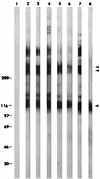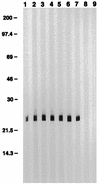Role of immunoglobulin A monoclonal antibodies against P23 in controlling murine Cryptosporidium parvum infection
- PMID: 9712802
- PMCID: PMC108540
- DOI: 10.1128/IAI.66.9.4469-4473.1998
Role of immunoglobulin A monoclonal antibodies against P23 in controlling murine Cryptosporidium parvum infection
Abstract
Cryptosporidium parvum is an important diarrhea-causing protozoan parasite of immunocompetent and immunocompromised hosts. Immunoglobulin A (IgA) has been implicated in resistance to mucosal infections with bacteria, viruses, and parasites, but little is known about the role of IgA in the control of C. parvum infection. We assessed the role of IgA during C. parvum infection in neonatal mice. IgA-secreting hybridomas were developed by using Peyer's patch lymphocytes from BALB/c mice which had been orally inoculated with viable C. parvum oocysts. Six monoclonal antibodies (MAbs) were selected for further study based on indirect immunofluorescence assay reactivity with sporozoite and merozoite pellicles and the antigen (Ag) deposited on glass substrate by gliding sporozoites. Each MAb was secreted in dimeric form and recognized a 23-kDa sporozoite Ag in Western immunoblots. The Ag recognized comigrated in sodium dodecyl sulfate-polyacrylamide gel electrophoresis with P23, a previously defined neutralization-sensitive zoite pellicle Ag. MAbs were evaluated for prophylactic or therapeutic efficacy against C. parvum, singly and in combinations, in neonatal BALB/c mice. A combination of two MAbs given prophylactically prior to and 12 h following oocyst challenge reduced the number of intestinal parasites scored histologically by 21.1% compared to the numbers in mice given an isotype-matched control MAb (P < 0.01). Individual MAbs given therapeutically in nine doses over a 96-h period following oocyst challenge increased efficacy against C. parvum infection. Four MAbs given therapeutically each reduced intestinal infection 34.4 to 42.2% compared to isotype-matched control MAb-treated mice (P < 0.05). One MAb reduced infection 63.3 and 72. 7% in replicate experiments compared to isotype-matched control MAb-treated mice (P < 0.0001). We conclude that IgA MAbs directed to neutralization-sensitive P23 epitopes may have utility in passive immunization against murine C. parvum infection.
Figures



Similar articles
-
Characterization and formulation of multiple epitope-specific neutralizing monoclonal antibodies for passive immunization against cryptosporidiosis.Infect Immun. 2000 May;68(5):2608-16. doi: 10.1128/IAI.68.5.2608-2616.2000. Infect Immun. 2000. PMID: 10768951 Free PMC article.
-
Protective monoclonal antibody defines a circumsporozoite-like glycoprotein exoantigen of Cryptosporidium parvum sporozoites and merozoites.J Immunol. 1997 Feb 15;158(4):1787-95. J Immunol. 1997. PMID: 9029117
-
Attempts to protect severe combined immunodeficient (scid) mice with antibody enriched for reactivity to Cryptosporidium parvum surface antigen-1.Vet Parasitol. 1995 Jul;58(4):281-90. doi: 10.1016/0304-4017(94)00729-v. Vet Parasitol. 1995. PMID: 8533267
-
Recent advances in cryptosporidiosis: the immune response.Microbes Infect. 2002 Aug;4(10):1067-80. doi: 10.1016/s1286-4579(02)01631-3. Microbes Infect. 2002. PMID: 12191657 Review.
-
Molecular targets for detection and immunotherapy in Cryptosporidium parvum.Biotechnol Adv. 2007 Jan-Feb;25(1):13-44. doi: 10.1016/j.biotechadv.2006.08.003. Epub 2006 Aug 30. Biotechnol Adv. 2007. PMID: 17055210 Review.
Cited by
-
Identification and characterization of a new 34 kDa MORN motif-containing sporozoite surface-exposed protein, Cp-P34, unique to Cryptosporidium.Int J Parasitol. 2021 Aug;51(9):761-775. doi: 10.1016/j.ijpara.2021.01.003. Epub 2021 Mar 25. Int J Parasitol. 2021. PMID: 33774040 Free PMC article.
-
Evidence of thymus-independent local and systemic antibody responses to Cryptosporidium parvum infection in nude mice.Infect Immun. 1999 Aug;67(8):3947-51. doi: 10.1128/IAI.67.8.3947-3951.1999. Infect Immun. 1999. PMID: 10417160 Free PMC article.
-
Cryptosporidiosis in HIV/AIDS patients in Kenya: clinical features, epidemiology, molecular characterization and antibody responses.Am J Trop Med Hyg. 2014 Aug;91(2):319-28. doi: 10.4269/ajtmh.13-0254. Epub 2014 May 27. Am J Trop Med Hyg. 2014. PMID: 24865675 Free PMC article.
-
Lessons Learned from Protective Immune Responses to Optimize Vaccines against Cryptosporidiosis.Pathogens. 2017 Dec 24;7(1):2. doi: 10.3390/pathogens7010002. Pathogens. 2017. PMID: 29295550 Free PMC article. Review.
-
Plant-Produced Chimeric VHH-sIgA Against Enterohemorrhagic E. coli Intimin Shows Cross-Serotype Inhibition of Bacterial Adhesion to Epithelial Cells.Front Plant Sci. 2019 Mar 12;10:270. doi: 10.3389/fpls.2019.00270. eCollection 2019. Front Plant Sci. 2019. PMID: 30972081 Free PMC article.
References
-
- Arrowood M J, Sterling C R. Isolation of Cryptosporidium oocysts and sporozoites using discontinuous sucrose and isopycnic Percoll gradients. J Parasitol. 1987;73:314–319. - PubMed
-
- Arrowood M J, Sterling C R, Healey M C. Immunofluorescent microscopical visualization of trails left by gliding Cryptosporidium parvum sporozoites. J Parasitol. 1991;77:315–317. - PubMed
-
- Banhamou Y, Kapal N, Hoang C, Matta H, Meillet D, Magne D, Raphael M, Gentilini M, Opolon P, Gobert J G. Inefficacy of intestinal secretory immune response to Cryptosporidium in acquired immunodeficiency syndrome. Gastroenterology. 1995;108:627–635. - PubMed
Publication types
MeSH terms
Substances
Grants and funding
LinkOut - more resources
Full Text Sources
Other Literature Sources
Medical
Miscellaneous

